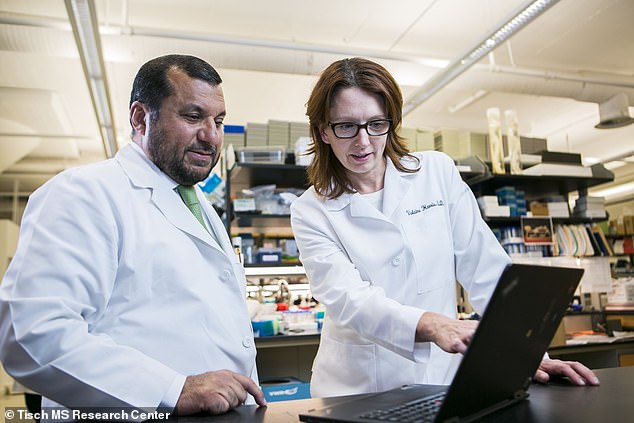How six ‘remarkable’ shots gave me my life back after doctors said nothing could treat my MS
When Robin Gordon-Cartier was first diagnosed with multiple sclerosis at age 50, she felt like she was “waiting to die.”
Her busy life as a harpist, full-time teacher and touring artist slowly deteriorated due to the disease, as she succumbed to daily pain, fatigue and a limping that worsened. She stopped performing altogether because she couldn’t carry her equipment with her.
Most disturbingly, her hands, which are the key to her complicated instrument, randomly went numb and tingled – as if she had sat on them for too long.
“I went straight down the hill, and that was that,” the New Jersey resident, now 64, told DailyMail.com. The first doctor she saw determined she had an advanced form of the disease that is resistant to available treatments and affects about a million Americans.
But in 2019, a new doctor enrolled her in a medical trial of a promising new treatment that used her body’s own cells to fight disease.
Robin Gordon-Cartier was first diagnosed with MS when she was 50 years old. No one in her family has the disease, but she found comfort and community in a colleague who was also diagnosed

Dr. Violaine Harris, from the Tisch MS Research Center in New York, led the stem cell research. She has worked at Tisch since 2004 and researches possible therapies for MS.
Now, five years after the injections – six in the course of a year – she has regained enough strength to carry her own harp to concerts.
She told DailyMail.com that she is much more stable on her feet, which has given her the confidence to travel again, allowing her to perform at weddings and concerts again.
Ms. Gordon-Cartier was one of 54 patients who in 2019 began receiving the new MS therapy, which was developed by scientists at the Tisch MS Research Center in New York and had been in the works since at least 2014.
The treatment, which involves injecting the spine with blank repair cells, “makes a big impact” on the quality of life for MS patients, Dr. Violaine Harris, Associate Director of Research at Tisch, who led the study, told DailyMail.com.
Multiple sclerosis is a condition that occurs when the immune system begins to attack the cells in your brain and spinal cord, shearing off the protective layer that insulates your nerves, called myelin.
Ultimately, this can cause the nerves to break.
Over time, the brain begins to lose tissue and the nerves have a harder time sending signals throughout the body, disrupting the way different parts of the body communicate.
This can make everything from walking to using the bathroom more difficult.
The disease can affect many different parts of the nervous system, so symptoms vary widely, but common early symptoms include weakness and tingling in the extremities, fatigue, mood swings, dizziness, or problems with bladder function.
MS affects about 1 million people in the US, according to the National MS Societyand it is four times more common in women than in men.
People rarely die directly from MS, but more often from complications the condition causes, such as severe urinary tract infections (UTIs) or falls.
Experts don’t yet know what causes the neurodegenerative disease, but it’s possible that genetics may play a role, as can a person’s environment.
Dr. Harris told DailyMail.com that if doctors knew what caused MS, it would be easier to treat it.
Currently, there are not enough treatments to alleviate the suffering of people with primary progressive MS, which affects approximately 100,000 to 150,000 Americans.
Primary progressive MS is a form of the disease in which people’s disease worsens slowly and steadily, without interruption. With this form of disease, there is no real relief from symptoms once diagnosed.
‘We had no problems with registration [patients]. There is a need for any form of treatment for this type of MS,” Dr. Harris said.

Ms. Gordon-Cartier teaches at a performing arts high school in New Jersey during the week, travels to concerts and weddings and attends conferences on weekends.

Dr. Harris along with Dr. Saud A. Sadiq, the director and chief research scientist of Tisch MSRCNY. Ms Gordon-Cartier said things changed for her during her MS treatment when she met Dr Sadiq, who made her feel like there was a way to fight back against the disease.
The potentially revolutionary treatment works by taking bone marrow, the spongy tissue that produces blood cells in a person’s bones, and applying a complex cocktail of drugs to the tissue to turn it into stem cells.
Stem cells are the blank cells that your body can use to make any of the different tissue types the body needs to function properly, including those in the heart, nerves, kidneys, muscles, and more.
Because stem cells can theoretically be turned into any type of cell in the body, Dr. Harris and her colleagues theorized that they could be used to rejuvenate nerve cells lost to MS.
The first trial, which ran from 2014 to 2016, suggested there was some potential. In it, the bone marrow of twenty patients was extracted and converted into stem cells, which were then reinjected into them three times, with three months between each injection.
In the short term, 75 percent of these patients were able to walk faster, reported less brain fog and were better able to control their bladder. However, in the two-year follow-up, these gains leveled off, indicating that the treatment had no long-term effects.
The phase two trial started in 2018, but was recently published in the journal Stem cell research and therapy. 54 participants received an injection of their stem cell six times over the course of a year, with two months between each treatment.
In the first year, half of the patients received the treatment and the other half a placebo.
In the second year the groups changed.
After treatment, people have better control of their bladder and can walk faster and more easily, Dr. Harris said.
Watching the videos of people walking side by side showed “remarkable” progress, Dr Harris said.
They even discovered that people lost less brain tissue when treated with stem cells.
But it wasn’t a cure.
It has not reduced disability in people in general, nor has it reversed the symptoms of MS.
Although people could walk much better and faster, they still had to use devices to do so.
In the first year of treatment, Ms. Gordon-Cartier was convinced she had the placebo; she didn’t feel any different.
But in the second year things started to get better. She said she felt more energetic, stable and better at moving.
Now, five years after she started treatment, she says the experimental treatment has given her back her strength and her life.
Dr. However, Green said the findings did not convince him that this therapy will be effective in treating most people with MS.
He said that if they did the same study again in the future and included other researchers outside the Tisch Center and saw similar results, it would be clearer evidence that the treatment is beneficial.
At this point, the study was small, so the observed differences could be due to chance, Dr. Green added.
“By chance alone, there can always be differences between two groups,” he explained.
However, he said it is possible that patients may benefit from treatment that science may not detect, such as brain dog, which is difficult to measure.
There are also many structural barriers that make it difficult to adopt stem cell therapies on a larger scale, Dr. Green said.
If this treatment were to prove effective, it would require further testing, meaning it could be years before the therapy becomes widely available to patients.
The researchers also face the challenge of figuring out how to produce personalized stem cells on a large scale, a technology that does not yet exist.
Despite the challenges, however, the first two study results are so encouraging that the FDA is in the process of approving the treatment for compassionate use, meaning people can apply to use it if they have no other options.
Stem cell therapy has also made promising progress in other areas. Recently, researchers in China cured a man with type 2 diabetes by injecting him with his own stem cells engineered to produce insulin.
Prior to that, small studies have shown that stem cells can help treat erectile dysfunction, lung disease, and possibly even blindness.
Ms Gordon-Cartier is well aware of the disadvantages of the treatment. She said it was painful to have her bone marrow harvested and the process of injecting the stem cells was uncomfortable.
Even though she knew these limitations, she said she would do the treatment again without hesitation: “Sign me up.
‘I would definitely do it again because I think it makes me stronger. I just feel stronger. My body feels stronger…I don’t have that scary MS reality where you feel weak and like you’re going to fall.”
